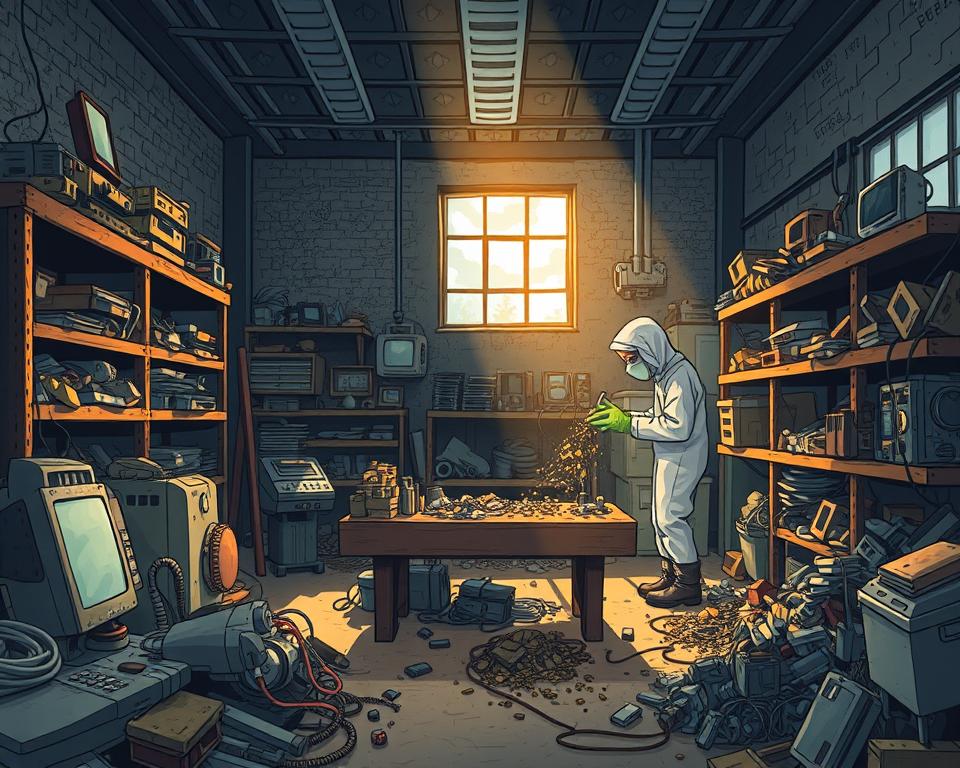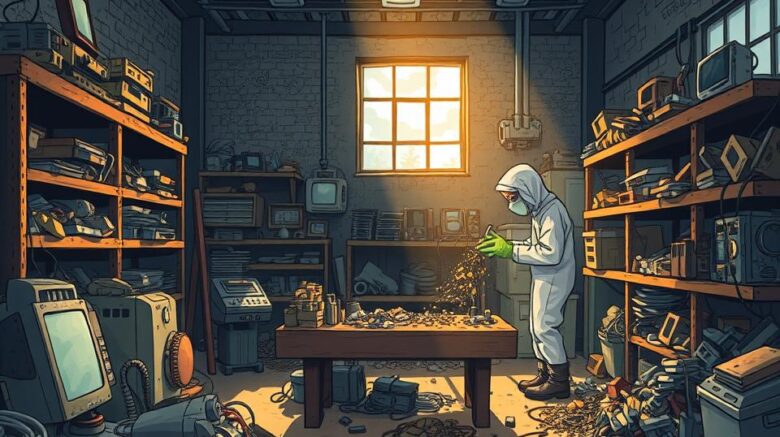Precious Metal Recycling: Your Eco-Friendly Guide
More than $60 billion in precious metals end up in e-waste every year—did you realize that? Such a massive amount highlights why precious metal recycling is so vital. Not only does it boost economic health, it also protects our environment. Reclaiming gold, silver, platinum, and palladium helps lower pollution and preserve what’s left of our natural resources.
Companies like Dongsheng Metal Trading are leading the charge towards sustainability. They ensure these valuable metals are reused, not dumped in landfills. That precious metal recycling strategy underpins green recycling and long-term sustainability.
Major Highlights
- Over $60 billion in precious metals is disposed of in electronic waste annually.
- Recycling precious metals shrinks environmental harm and saves resources.
- Key precious metals are gold, silver, platinum, and palladium.
- Sustainable development depends on eco-friendly recycling.
- Recycling experts like Dongsheng Metal Trading lead the industry.
What Makes Precious Metals So Valuable
Rare metallic elements known as precious metals attract both investors and manufacturers. Gold, silver, platinum, and palladium are prime examples, known for their unique properties. These include electrical conductivity, corrosion resistance, and substantial rarity. Given the resource-intensive mining and processing, recycling precious metals is essential.

Market demand and each metal’s properties drive its value. Recycling precious metals plays a critical role in sustaining the supply chain. It lowers the ecological damage from mining. By thorough recycling, these metals return to their pure form. Such efforts save limited resources and create economic gains.
Precious Metals Explained
Precious metals possess unique characteristics that make them desirable for a variety of applications. Scarcity plus special properties drive their economic importance. Notable examples are:
- Au: Prized for its shine and tarnish-proof nature.
- Ag: Recognized for its versatility and high conductivity.
- Platinum: Celebrated for its durability and catalytic properties.
- Palladium: Gaining traction in cars and electronics.
Benefits of Precious Metal Recycling
The practice of recycling precious metals has emerged as a vital component for sustainability. It saves scarce materials and sharply cuts mining’s eco-footprint. Here are some benefits:
- Reduction of environmental degradation caused by mining operations.
- Using far less energy than fresh extraction.
- Feeding materials back into the production loop.
- Opportunity for profit by recovering valuable metals.
Why Precious Metal Recycling Matters
Metal recycling brings both green and economic gains. Emphasizing benefits helps cut environmental harm. Additionally, it fuels market growth and resilience.
Green Benefits
Green gains from metal recycling are huge. Retrieving metals from scrap and electronics reduces landfill load. That cuts new mining needs and saves resources.
It lessens mining impacts, including ecosystem harm and contaminants. Focusing on recycling precious metals helps us strive for a more sustainable future.
Financial Gains
Financial perks of recycling are just as strong. Recycling precious metals can lower manufacturing costs. It lets businesses choose reclaimed over freshly mined metals.
This shift creates jobs in recycling facilities and boosts market stability as demand for recycled metals grows. Using these financial benefits, companies can improve profits. They also contribute to a greener economy.
Steps in Metal Recycling
Metal recycling demands a multi-stage process to optimize recovery. First, scrap electronics, jewelry, and industrial waste are gathered. Next comes sorting, cleaning, and testing to assess metal content and worth.
Recycling Workflow
A structured workflow is key to high-yield recovery. Every phase aims to maximize precious-metal returns. Metals are sorted according to their type and purity. Decontamination eliminates residues that block recovery. Testing measures metal content to select proper recycling methods.
Recovery Methods
High-tech methods are used to maximize metal retrieval. One method, thermal reduction, leverages heat to separate metals from base materials. Melting refines and aggregates metals, while wet chemical processes are used for delicate separations. Recyclers like Dongsheng Metal Trading employ these approaches to improve yields and returns.
Which Precious Metals Are Recyclable
Recovery efforts support both ecology and resource reclamation. Many precious metals can be recycled, benefiting both the economy and the planet. Awareness of recyclable metals guides consumers and companies.
Key Precious Metals
Gold, silver, and platinum are well-known precious metals. They appear in jewelry, coinage, and industrial components. Gold’s high price and use make it a prime recycling target. Silver’s role in cameras, electronics, and solar energy makes its recycling vital.
Platinum, while rarer, finds value in catalytic converters.
E-Waste Metals
Electronics scrap contains metals ripe for recovery. Gadgets—from phones to laptops—house palladium, indium, and more. Recovering such metals diminishes e-waste and yields vital materials.
Recycling these electronics metals is imperative. Sectors strive to cut waste and boost recycling efficiency.
Industries that Benefit from Precious Metal Recycling
Metal recovery underpins major sectors by supplying reclaimed resources sustainably. Device manufacturing in electronics profits hugely from recovered metals. Aerospace and healthcare rely on them for vital parts. Looking at their recycling practices shows green and financial gains.
Tech Electronics
The electronics industry leads in precious metal recycling due to the abundance of valuable metals in devices like smartphones and computers. Quick device turnover spawns more electronic scrap. Hence, recovering metals like gold, silver, and palladium is crucial. It preserves nature and lowers mining-driven CO₂ emissions.
Firms ramp up recycling to hit sustainability targets. Such a move upholds efforts to conserve and protect.
Aerospace & Medical
Aerospace metal recycling is vital for the aerospace and medical industries, which rely on precious metals for critical components. High-performance alloys are essential for manufacturing flight parts and medical devices due to their durability and resistance to corrosion. Metal recovery slashes expenses and ensures eco-compliance.
Both industries understand that responsible recycling practices help mitigate resource scarcity. And it improves operations, making metal recycling a smart green tactic.
Finding Precious Metal Recycling Companies
Choosing reputable metal recyclers is vital for success. Be sure to quiz them on their methods. Knowing their pricing and processing methods can greatly affect your experience. Service comparisons help you pick the best recycler.
What to Ask a Recycler
- Can you share your precious-metal recovery accreditations?
- Can you explain your processing methods for different metals?
- What are your recovery rates for various precious metals?
- Can you detail your fees and any surcharges?
- Can you share feedback from past customers?
Evaluating Offers
Comparing recyclers’ offerings is crucial when choosing one. Create a table to compare key factors such as:
| Company Name | Recovery Rate (%) | Processing Fee ($) | Turnaround Time (Days) |
|---|---|---|---|
| Recycling Co. A | 95 | 50 | 7 |
| Recycling Co. B | 90 | 45 | 5 |
| Recycling Co. C | 92 | 55 | 10 |
By comparing recycling services, you can find the best recycler for your needs. It guarantees maximum value and compliance.
Precious Metal Recycling: Your Eco-Friendly Guide
Knowing recycler operations matters if you recycle metals. They handle all stages, from gathering to final refining. That approach drives top efficiency and returns.
Behind the Scenes of Recycling
Recyclers use advanced methods for metal recycling, including testing, separation, and refining. First, they gather scrap from multiple origins. Then, they use sophisticated techniques to separate different metals. Next, they refine these metals to extract precious elements like gold, silver, and platinum.
That workflow both boosts recovery and promotes green methods. It’s a critical step towards sustainable development.
Choosing the Right Recycler for Your Needs
You’ll want to weigh several factors in your choice. Begin by checking their green credentials. Now more than ever, green commitment is crucial. Also, consider the services they offer, from basic collection to full processing.
Your budget will influence your choice. Get quotes to compare different options. Companies like Dongsheng Metal Trading offer customized solutions for various industries. They stand out as dependable recyclers.
Types of Recycling Facilities
Metal recycling is a critical sector for sustainable practices and waste management. There are specialized centers for different metals and materials. Understanding these facilities improves access to recyclers and their services. That supports firms and ecosystems alike.
Types of Facilities Available
There’s a broad spectrum of recycling operations. Some focus on precious metals, while others handle a wide range of materials. Here are a few common types:
- General scrap yards handle both ferrous and non-ferrous materials.
- High-value metal recyclers provide precision recovery for gold, silver, platinum, etc.
- E-Waste Recycling Centers: Specialize in recovering metals from discarded electronics, capitalizing on the valuable components often found in these devices.
Choosing Facility Locations
Accessibility to recyclers is key for efficient metal recovery. Companies should evaluate haulage considerations. Key access factors include:
| Factor | Description |
|---|---|
| Distance | Closer sites cut shipping costs and delays. |
| Partnerships | Connections with nearby facilities speed up recycling. |
| Service Range | Knowing each facility’s offerings guides your choice. |
Choosing appropriate centers and easy access drives recovery efficiency.
E-Waste Recycling & Metal Recovery
Electronic waste is a pressing issue in today’s world, causing environmental harm. Old gadgets hide valuable metals ripe for recovery. It shows why we should treat e-waste as treasure.
Electronic Precious Metals
Gadgets harbor small quantities of precious metals. You’ll find them in components such as:
- Circuit boards
- Connectors and ports
- Capacitors and resistors
- Battery terminals
From phones to TVs, electronics pack precious metals. With recycling, we can efficiently recover and reuse them.
Why Recycle E-Waste?
E-waste recycling is vital for both environmental protection and resource recovery. It reduces landfill waste and saves natural resources. Key perks include:
- It minimizes environmental risks from improper disposal
- It cuts down on carbon emissions through eco-friendly practices
- It bolsters circular models by returning scrap to production
Encouraging electronic recycling promotes sustainable resource management. It lays the groundwork for a greener future.
Future Trends in Metal Recovery
Recycling is changing fast thanks to new tech and eco-driven demand. As the need to conserve resources grows, major players in recycling are adapting. They are embracing new methods and processes, setting the stage for the future of recycling precious metals.
Green Recycling Trends
Today’s sustainable recycling prioritizes waste reduction and low impact. Businesses adopt green packaging and energy-saving techniques. Such moves match worldwide green goals and nudge industries to be more eco-responsible.
Cutting-Edge Recovery Methods
New methods in recovery enhance recycling performance. Automated sorters and hydrometallurgy ramp up yield. They ramp up yields and shrink eco-footprints, advancing metal recycling.
How to Start Your Own Precious Metal Recycling Business
Launching a metal recovery firm requires careful strategy and market insight. Entrepreneurs must outline key steps to build a strong foundation and adhere to industry regulations. That means in-depth market analysis and client identification. Securing licenses and legal compliance is crucial for long-term viability.
Steps to Establishing a Business
Setting up a precious metal recycling venture requires several essential steps:
- Research the market to grasp demand and competition.
- Develop a detailed business plan outlining goals and strategies.
- Invest in equipment tailored to your process needs.
- Secure funding through loans or investments.
- Get all required permits and licenses.
- Launch marketing to attract clientele.
Regulatory & Certification Needs
Understanding legal aspects when starting a precious metal recycling business is critical. Adherence to environmental regulations ensures your operation is safe and sustainable. Key considerations include:
- Securing business certification from relevant authorities.
- Ensuring full compliance with disposal and recycling laws.
- Training staff in safety protocols and best practices.
The Bottom Line
Recycling metals saves resources and boosts ecological well-being. It empowers all of us to reduce environmental harm from waste. That reclaimed metal cuts mining demand and spawns recycling jobs.
Recycling goes beyond environmental benefits, also providing economic advantages. Partnering with companies like Dongsheng Metal Trading ensures a commitment to eco-friendly practices. Such alliances reinforce the circular economy for all stakeholders.
Our path to sustainability relies on united metal recovery initiatives. Raising awareness fosters mindful use and eco stewardship. Adopting these practices will benefit us now and secure a greener future for generations to come.
